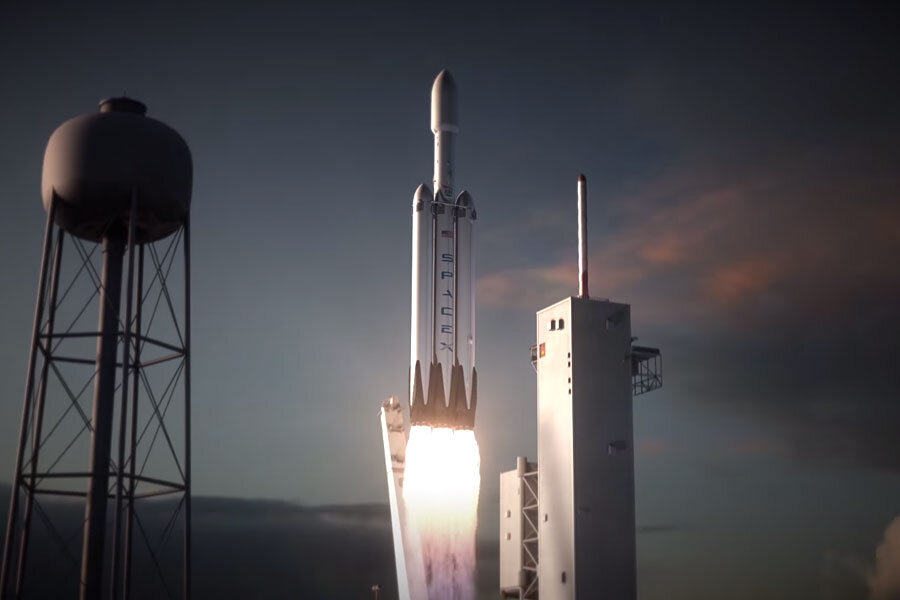Spectacular SpaceX animation shows Falcon Heavy rocket
Loading...
SpaceX released a cool new animation today, Jan. 27, showing an updated look at their Falcon Heavy rocket and plans for booster recovery. See below.
The Falcon Heavy is the brainchild of billionaire entrepreneur Elon Musk, SpaceX CEO and founder and illustrates his moving forward with the firms next giant leap in spaceflight.
The rocket is designed to lift over 53 tons (117,00 pounds) to orbit and could one day launch astronauts to the Moon and Mars.
The commercial Falcon Heavy rocket has been under development by SpaceX for several years and the initial launch is now planned for later this year from Launch Complex 39A at the Kennedy Space Center (KSC) in Florida.
The new rocket is comprised of three Falcon 9 cores.
The Falcon Heavy will be the most powerful rocket developed since NASA’s Saturn V rocket that hurled NASA’s Apollo astronauts to the Moon in the 1960s and 1970s – including the first manned landing on the Lunar surface by Neil Armstrong and Buzz Aldrin in July 1969.
Here is the updated animation of the SpaceX Falcon Heavy flight and booster recovery:
The video shows the launch of the triple barreled Falcon Heavy from Launch Complex 39A at NASA’s Kennedy Space Center in Florida. Then it transitions to the recovery of all three boosters by a guided descent back to a soft touchdown on land in the Cape Canaveral/Kennedy Space Center area.
SpaceX, headquartered in Hawthorne, Calif., signed a long term lease with NASA in April 2014 to operate seaside pad 39A as a commercial launch facility for launching the Falcon Heavy as well as the manned Dragon V2 atop SpaceX’s man-rated Falcon 9 booster.
Launch Complex 39A has sat dormant for over three years since the blastoff of the final shuttle mission STS-135 in July 2011 on a mission to the International Space Station (ISS).
SpaceX is now renovating and modifying the pad and the Fixed and Mobile Service Structures, RSS and FSS. They will maintain and operate Pad 39A at their own expense, with no US federal funding from NASA.
When it does launch, the liquid fueled Falcon Heavy will become the most powerful rocket in the world according to SpaceX, generating nearly four million pounds of liftoff thrust from 27 Merlin 1D engines. It will then significantly exceeding the power of the Delta IV Heavy manufactured by competitor United Launch Alliance (ULA), which most recently was used to successfully launch and recover NASA’s Orion crew capsule on its maiden unmanned flight in Dec. 2014
SpaceX recently completed a largely successful and history making first attempt to recover a Falcon 9 booster on an ocean-going “drone ship.” The rocket nearly made a pinpoint landing on the ship but was destroyed in the final moments when control was lost due to a loss of hydraulic fluid.
Read my story with a SpaceX video – here – that vividly illustrates what SpaceX is attempting to accomplish by recovering and ultimately reusing the boosters in order to dramatically cut the cost of access to space.
Stay tuned here for Ken’s continuing Earth and planetary science and human spaceflight news.
Dr. Ken Kremer is a speaker, research scientist, freelance science journalist (Princeton, NJ) and photographer whose articles, space exploration images and Mars mosaics have appeared in magazines, books, websites and calendars including Astronomy Picture of the Day, NBC, BBC, SPACE.com, Spaceflight Now and the covers of Aviation Week & Space Technology, Spaceflight and the Explorers Club magazines. Ken has presented at numerous educational institutions, civic & religious organizations, museums and astronomy clubs. Ken has reported first hand from the Kennedy Space Center, Cape Canaveral, NASA Wallops, NASA Michoud/Stennis/Langley and on over 40 launches including 8 shuttle launches. He lectures on both Human and Robotic spaceflight - www.kenkremer.com. Follow Ken on Facebook and Twitter
Originally published on Universe Today.





